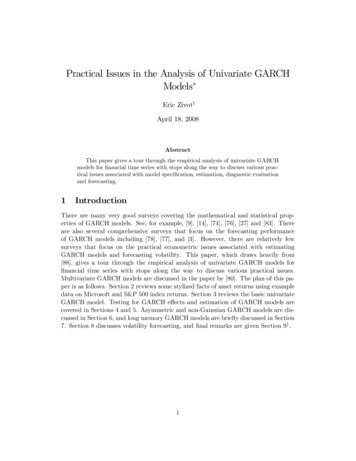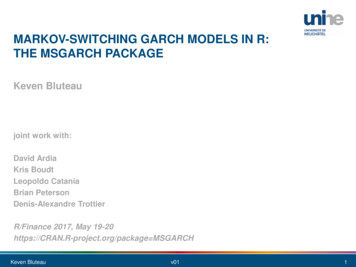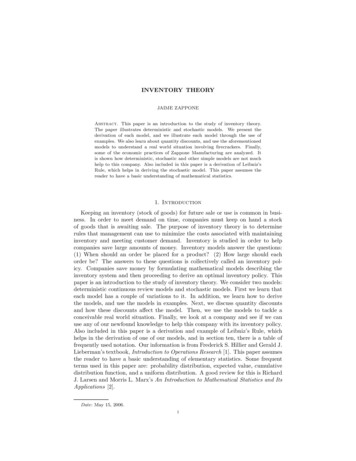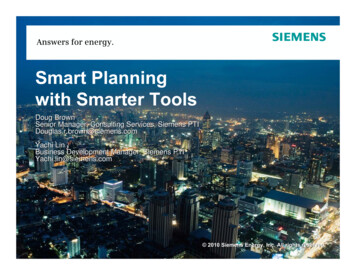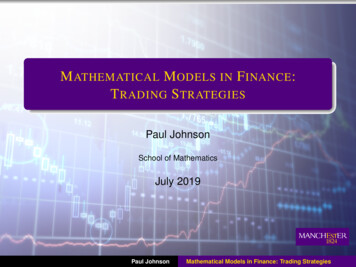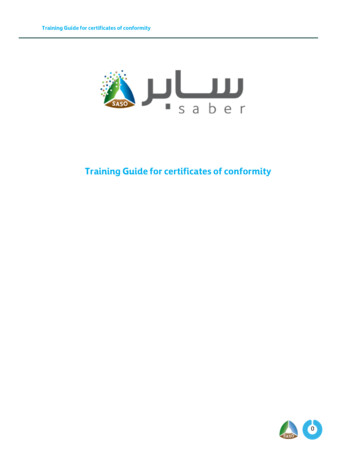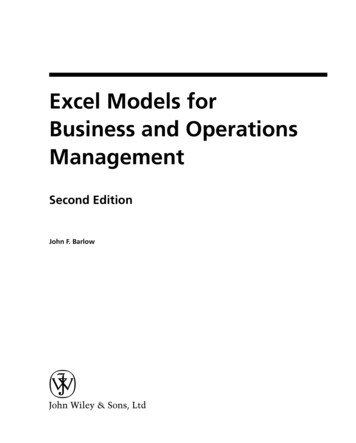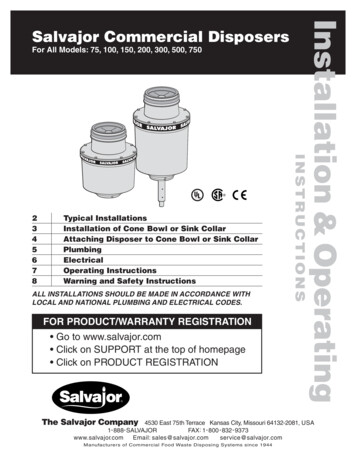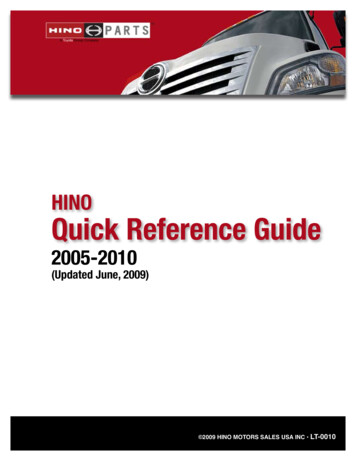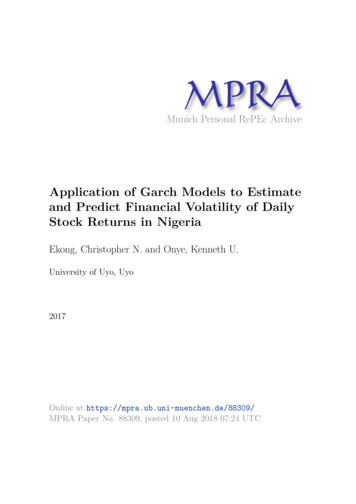
Transcription
Munich Personal RePEc ArchiveApplication of Garch Models to Estimateand Predict Financial Volatility of DailyStock Returns in NigeriaEkong, Christopher N. and Onye, Kenneth U.University of Uyo, Uyo2017Online at https://mpra.ub.uni-muenchen.de/88309/MPRA Paper No. 88309, posted 10 Aug 2018 07:24 UTC
Application of Garch Models to Estimate and Predict FinancialVolatility of Daily Stock Returns in NigeriaChristopher N. Ekong, Kenneth U. OnyeDepartment of Economics, Faculty of Social Sciences, University of UyoAbstract: This paper estimates the optimal forecasting model of stock returns and the nature of stock returnsvolatility in Nigeria using daily All-Share stock data. The study unlike previous ones estimates six sets ofsymmetric and asymmetric GARCH-family models of stock returns volatility (three of which are augmented withtrading volume) in three different set of error distributions: normal, student’s t and generalized errordistribution (GED) with a view to selecting the model with best predictive power. Relying on root mean squareerror (RMSE) and Thiel’s Inequality Coefficient, GARCH (1,1) and augmented EGARCH(1,1) in GED provedto possess the best forecasting capability as adjudged by the last 30 days out-of-sample forecast. Our findingalso suggests the presence of leverage effect and decline in persistence parameter after incorporating tradingvolume. Overall, the result provides evidence of high probability of making negative return from investment inthe Nigerian stock market over the sample period. The empirical merit of the model is, thus, its potential forapplications in analysis of value at risk (VaR) of quoted stocks and, therefore, evaluation of risk premia thatguide investors’ choice of stock portfolio.Keywords: Stock Returns, Forecasting, GARCH Model, Nigeria1. INTRODUCTIONAn established feature of stock returns is that they exhibit volatility clustering1, i.e., periods of swingfollowed by periods of relative calm (Harvey and Chakravarty, 2008). In this regard, it wasdiscovered that, for vast classes of models, the average size of volatility is not constant but changeswith time in a manner that is predictable. Interestingly, the generalized auto-regressive conditionalheteroscedasticity (GARCH) model introduced by Bollerslev (1986) and Taylor (1986) is among theoldest most widely used models for capturing volatility/risk, i.e., changing variances, in financial timeseries that exhibit time-varying volatility clustering2. Increasingly too, studies on the volatility ofstock returns which have been dominated by time series models of conditional heteroscedasticity havetended to find strong supports for asymmetric ARCH/GARCH-type effect. In Nigeria, however, thecontributions of error distributions seems to have been ignored while modeling stock market volatilityeven though past and recent studies have shown that the application of appropriate error distributionin volatility models enhances the efficiency of a model (see for e.g., Chang, 2010; Jiang, 2012).More so, the ARCH/GARCH –type models do not provide a theoretical explanation of volatility orwhat, if any, the exact contribution of information3 flows are in the volatility-generating process. In1Other stylized facts (features) of stock returns are heavy tails (conditional fat- tailed-ness), leverage (volatilityasymmetry) and conditional skewness. Leverage means that negative returns tend to be associated with highervolatility than positive returns of the same magnitude. Fat tailed-ness means that the standardized conditionalreturns is more fat-tailed than the Gaussian (normal) returns while conditional skewness means that thestandardized returns is not symmetric. For stock returns the skewness is typically negative which means that theprobability of large negative return is greater than large positive returns– even after adjusting for the recent levelof volatility.2As Engle, Focardi and Fabozzi (2007:2) note, the discovery that it is possible to formalize and generalize thisobservation was a major breakthrough in econometrics.3As we see in Engle, Farcodi and Fabozzi (2007) too, trade volume provide information that could help explainhigh stock return volatility using high frequency data.
this regard, one of the early attempts4 to provide a theoretical explanation to volatility-generationprocess is the mixture of error distribution hypothesis (MDH) advanced by Clark (1973), and Eppsand Epps (1976) (see e.g., Tauchen and Pitts, 1983; Lamoureux and Lastrapes, 1990for empiricalevidences). According to MDH, the variance of stock returns at a given interval is proportional to therate of information arrival. As a result, volatility clustering could be a reflection of information arrivalfrequencies. All traders receive the new price signals fairly simultaneously and, therefore, the shift toa new equilibrium is immediate and there will be no intermediate partial equilibrium.The specification of appropriate volatility model for capturing fluctuations in stock returns is ofsignificant policy relevance to investors and policy makers alike. First, reliable volatility model ofasset returns aids investors in their risk management decisions and portfolio adjustments. The searchfor reliable volatility model is also important because unfettered fluctuation in asset return couldinfluence investment decision that can manifest in the real sector with adverse consequences foreconomic growth and development. Second, undue swings in asset returns could impose challenges tomonetary policy formulation and consequently undermine the price stability objective of the monetaryauthority. For instance, increase in stock prices leads to higher interest rate (see Fischer 1981)thatcould generate inflationary spree in the economy (see Spiro, 1990).As De Gruwe (2008) argues, assetprice inflation inevitably lead to crashes. In this regard, stabilization policy is needed since thosepolicies that stabilize asset price can also stabilize inflation and output. Therefore, the determinationof the nature of stock returns volatility and its optimal forecasting model makes a crucial precondition for the Central Bank‟s intervention in the Nigerian Stock Market.The paper has two-fold objectives, namely to: (i) examine the nature of volatility/risk of stock returnsin Nigeria and (ii) determine the optimal forecasting model for Nigerian stocks and theirpredictability.Similar study has been done by Chiang (2010) who analyzed the Chinese stock exchange, Jiang(2012) who analyzed the New York stock exchange and Tian and Guo (2006) who analyzed theShangai and Shenzhen exchanges of the Chinese Stock market. We apply the commonly usedGARCH-family models on Gaussian (normal), student‟s t and generalized error distribution with aview to selecting the best forecasting volatility model with the appropriate error distribution for theNigeria stock market over the sample period.The rest of the paper is organized as follows. Section 2 deals with the theoretical and empiricalliterature, and the analytical framework of GARCH- family models adopted for the study while themethodology and data is presented in section 3. Section 4 discusses the results with applications andsection 5 concludes the paper.2. LITERATURE REVIEWThis sub-section, as has been noted, deals with the review of relevant theoretical and empiricalliterature on modeling the volatility of stock returns. The analytical scheme – i.e., the specifictechnique chosen to investigate stock returns volatility – namely the GARCH-family models, adoptedfor the study is also discussed.2.1. Theoretical LiteratureThe use of auto-regressive conditional heterosceadsticity models for analyzing volatility of assetreturns was due to the pioneering work of Engle (1982) where the conditional variance of adisturbance term was made a function of linear combination of squared residuals in the recent past.Progressively, the potential of the ARCH model spurred a number of other researches that resulted inthe development of several other ARCH-type models. As we see in Rydberg (2000), the fact that largelag values are required in the ARCH models implies that many parameters are needed whichsometimes lead to over-parametization.To achieve a parsimonious model, therefore, Bolerslev (1986) and Taylor (1986) independentlyproposed the extension of ARCH model with an Autoregressive Moving Average (ARMA)formulation. This model, which is popularly called the Generalized ARCH model (GARCH), models4Alternative explanation of volatility clustering include the existence of autocorrelation in the news arrivalprocess of Diebold and Nerlove (1989); Sequential Information arrival hypothesis of Copeland (1976); andmarket microstructure effects of Bollerslev and Domowitz (1991).
conditional variance as a function of its lagged values as well as squared lagged values of thedisturbance term. Although, the GARCH model has proved very useful in capturing symmetric effectof volatility, it has certain limitations. For instance, it assumes that positive and negative error termshave a symmetric effect on volatility, i.e., good and bad news have the same size of effect onvolatility in the model. In practice, this assumption is frequently violated by stock returns, inparticular, in that volatility tends to increase more after bad news than after good news (especially innon-crisis periods), the so-called leverage effect (first proposed by Black, 1976). Technically, thisassumption implies that the estimated parameters in the GARCH model are restricted to a positivevalue, the so-called non-negativity parameter restriction. In other words, a major limitation of theGARCH model is that in reality the non-negativity constraint imposed on the parameter of theGARCH model is frequently violated5.To overcome these constraints, the asymmetric GARCH-family models (which are extensions of theoriginal GARCH model) have been proposed. These include the Exponential GARCH model(EGARCH) proposed by Nelson (1991), the Power GARCH (PGARCH) proposed by Ding, Grangerand Engle (1993), the Threshold GARCH (TGARCH) proposed by Zakoian (1994), and the Beta-tGARCH family models proposed by Harvey and Chakravarty, 2008) and elaborated in the ensuingliterature by Harvey and Sucarrat (2012).The central idea behind this asymmetric GARCH-familymodel is the leverage effect, i.e., the fact that in reality good and bad news of the same magnitudehave differential effects on the volatility (conditional variance) of stock returns.The Exponential GARCH model which captures the asymmetric properties of stock returns volatilitywas proposed to address three principal deficiencies of GARCH model. These are: (i) restriction ofthe estimable parameters to a positive value to ensure positive effect on conditional variance; (ii)absence of asymmetric response of volatility to shocks (e.g. from lagged residuals, variances and/ortrade volumes), i.e., absence of asymmetric term in GARCH model; (iii) difficulty in measuringvolatility persistence in a strongly stationary series. The use of log-conditional variance in theEGARCH model rather than conditional variance (as is the case in normal GARCH model) impliesthat the leverage effect (asymmetric response of volatility) is exponential and not quadratic. In otherwords, the specification of volatility (conditional variance) in terms of its logarithmic transformationimplies that the parameters are no longer restricted to positive value. That is, the more realistic casewherein volatility response differentially to good news (positive shock) and bad news (negativeshock) of the same magnitude is captured. This is a key advantage of EGARCH model over thesymmetric GARCH model.In Ding, Granger and Engle (1993), the standard deviation of GARCH model initially proposed byBollerslev (1986), Taylor (1986) and Schwert (1989) is further generalized in such a way that theconditional standard deviation is raised to a power, d (positive exponent). The d-power conditionalstandard deviation is modeled as a function of lagged conditional standard deviation and laggedabsolute innovations raised to the same power (d). The resultant model is called the power GARCH.The expression becomes a standard GARCH model when the positive exponent is set at two.Interestingly, the provision for the switching of the power increases the flexibility of themodel.Similarly, in Zakoian (1994), the TGARCH model is specified by allowing the conditional standarddeviation in the standard GARCH to depend on the sign of lagged innovations. This specificationdoes not restrict parameter to a positive value. As has been said, one may note that parameterrestriction to positive value is meant to guarantee the positivity of volatility (conditional variance).Nonetheless, to ensure stationarity of the TGARCH model, the parameters have to be restricted andthe choice of error distribution should account for the stationarity. The TGARCH model is closelyrelated to the GJR-GARCH model developed by Glosten et al. (1993).It is insightful to note that in response to the criticism concerning the a-theoretical nature of GARCHfamily models, the standard asymmetric GARCH-family models are now augmented with tradingvolume. In this regard, the pioneering work of Lamoureux and Lastrapes (1990) have found evidence5In this regard, the asymmetric coefficients of asymmetric GARCH-family model are allowed to assumepositive or negative values.
that the inclusion of trading volumes in GARCH models of return results in a decrease of theestimated volatility persistence or even causes it to disappear. Few studies have, however, foundpersistence in volatility even after incorporating trading volume as an information variable (see e.g.Najand and Yung, 1991; Chen et al, 2001). This show that the effect of trading volume on stockreturns volatility is still an empirical issue. This study, therefore, finds it necessary to test the effect oftrade volume in explaining stock returns volatility in the context of the Nigerian stock market.In term of choice of appropriate error distribution, economics and finance literature is also notunequivocal over appropriate choice of error distribution (normal, student-t or generalized errordistribution) for robust modeling of stock returns. Since stock returns are characterized by certainstylized facts such as volatility clustering, leverage effect (asymmetric response of volatility topositive and negative shocks of the same magnitude) and are frequently fat-tailed, the traditionalassumption of normality in volatility modeling of stock returns could lead to less than robustregression estimates. As we see in Mandelbrot (1963) and Fama (1965), it is deduced that daily stockreturns are non-Gaussian and tend to have leptokurtic and fat-failed distribution. For this reason,Bollerslev (1986) relaxed the traditional normality assumption to accommodate time varying volatilityby assuming that the error is student-t distributed. Similarly, Malmsten and Terasvirta (2004) arguethat first order EGARCH model in normal error is not sufficiently flexible enough for capturingkurtosis and autocorrelation in stock returns. They, therefore, suggested that the standard GARCHmodel could be improved by replacing the normal error distribution with more fat-tailed errordistribution since increasing the kurtosis of the error distribution will help standard GARCH modelcapture kurtosis in stock returns series.In this same line of thinking, Nelson (1991) recommended the use of EGARCH model withgeneralized error distribution (GED) based on, at least, two of its desirable properties. First, a studentt error distribution may imply infinite unconditional variance for the errors; hence, the GED whichaccommodates more fat-tails than normal error distribution could help to increase the kurtosis andreduce the autocorrelation of squared observation. Second, the EGARCH model is stationary if theinnovations have a generalized error distribution (GED).This study, therefore, estimates first ordersymmetric and asymmetric GARCH-family models, each, in Normal, Student‟s-t and generalizederror distributions (GED) with a view to determining the volatility model with best predictive powerin the most appropriate error distribution. This is important not only for proper forecasting of stockreturn in Nigeria that guide investor‟s portfolio choice, it is also necessary for accurate assessment ofvalue at risk (VaR). Importantly, the determination of optimal forecasting model of stock returnsmakes a crucial pre-condition for the Central Bank‟s intervention in the stock exchange market.2.2. Review of Empirical LiteratureFollowing the seminal work of Engle (1982) on volatility modeling, several other works have beendone. Yet, certain theoretical/empirical issue, such as the effect of error distribution assumption on theconditional variance (volatility)and forecasting performance of GARCH family models, is scarce andunresolved (see Franses and McAleer, 2002;Anders, 2006). Some of the works on volatility modelingestimate a particular GARCH model with one or two error distributions, while some apply a particularerror distribution to few ARCH family models to either: (i) establish the best forecasting model forconditional variance; (ii) determine the best fitted volatility model or; (iii) confirm the ability of amodel to capture stylized facts inherent in high frequency financial time series. As has been noted, thecontribution of trade volume (as a surrogate for information arrival to explain stock return volatility)and error distribution assumption on the forecasting performance of returns volatility is very scanty(minimal). As Atoi (2014) notes, available literature tend to capture the asymmetric properties offinancial data without recourse to error distribution.Jayasuriya (2002) examines the effect of stock market liberalization on stock returns volatility inNigeria and fourteen other emerging market data, from December 1984 to March 2000 to estimatesymmetric GARCH model. The study found that positive (negative) changes in prices have beenfollowed by negative (positive) changes in volatility. The Nigeria portion of the result indicates moreof business cycle behavior of stock return rather than volatility clustering. In studying volatilitybehavior of stock returns for emerging markets, Ogum et al (2005) apply the Nigerian and Kenyastock data on EGARCH model. The finding differed from that of Jayasuriya (2002). Althoughvolatility persistence was found in both markets; volatility responds more to negative shocks in theNigeria market and the reverse is the case for Kenya market.
Okpara and Nwezeaku (2009) randomly selected forty one companies from the Nigerian stockExchange to examine the impact of beta and idiosyncratic risk on returns using data from 1996 to2005. By relying on EGARCH (1, 3) model, the result shows less volatility persistence and indicatesthe presence of leverage effect in the Nigerian stock exchange, implying that bad news (negativeshock) drives volatility more than good news (positive shock) of equal magnitude. Dallah and Ade(2010) investigated the volatility of daily stock returns of Nigerian insurance stocks using daily datafrom twenty six insurance companies covering a period of December 15, 2000 to June 9, 2008 ascontrol data set and from June 10 2008 to September 9, 2008 as out-of-sample dataset. The results ofARCH (1), GARCH (1,1), TARCH (1,1) and EGARCH (1,1) indicate that EGARCH is more suitablein modeling stock returns as it outperforms the other models in the model-fit evaluation (usingSchwarz and Aikike information ) and out-of-sample forecast (using RMSE and Thiel‟s InequalityCoefficient).A too I (2014) examines a set of first order symmetric and asymmetric ARCH family model usingdaily Nigerian All Shares Index (ASI) from June 2, 2008 to February 11 2013 under alternative errordistributions (normal, student-t, and generalized error distribution). The result shows that PGARCH(1, 1, 1) in student-t error distribution has the best predictive power based on root mean square error(RMSE) and Theil‟s inequality coefficient (TIC). The findings also shows the presence of leverageeffect and recommends that empirical works should consider alternative error distributions so as toguarantee robust volatility forecasting model for sound policy decision and proper investmentportfolio choice.Chang (2010) analyzes the effect of the economic and financial crisis on Chinese stock returnvolatility using daily data from 2000 to 2007 as the pre-crisis period and 2007 to 2010 as the duringcrisis period. The findings show that the EGARCH model fits the data better than the GARCH modelin modeling the volatility of Chinese stock returns. The result also indicates that volatility is morepersistent during crisis period than in pre-crisis period.Dallah and Ade (2010) examined the volatility of daily stock returns of the Nigerian insurance stocksusing daily data from twenty six insurance companies. The period December 15, 2000 to June 9, 2008was considered as the training data set and from June 10, 2008 to September 9, 2008 as out-of-sampledata set. The result of ARCH (1), GARCH (1,1), TGARCH(1,1) and EGARCH(1,1) indicates thatEGARCH(1,1) is more suitable in modeling stock price returns as it outperforms the other models inmodel evaluation and out-of-sample forecast.An evaluation of the state of literature on GARCH family models shows that alternative errordistributions (normal or Gaussian, student‟s t and generalized error distribution) have so far beenignored in modeling the volatility of stock returns in Nigeria. This study adds value to existing studiesin this area by modeling stock returns volatility in three alternative error distributions with a view toselecting an optimal forecasting model for Nigeria. Further, in response to criticism concerning the atheoretical nature of volatility models, this study includes trading volume as an information variable(as suggested by Lamoureux and Lastrapes, 1990; Najand and Youn, 1991; Chen at al, 2001) toexplain volatility of stock return in Nigeria.2.3. Analytical Framework of ARCH/GARCH Family ModelsThe ARCH Model (Engel 1982 Model)Every ARCH or GARCH family model requires two distinct specifications: the mean and varianceequations. According to Engel, conditional heteroscedasticity in a stock return (SRET) – denoted byyt– can be modeled using ARCH model expressing the mean equation in the form:(1)Equation 1 is a „q‟ order autoregressive model. The mean equation is the same for all ARCH/GARCHfamily models.εt σ1 v1, where v1 i. i. d. N (0,1), i.e., the residual (εt) is independent and identically distributedwith a mean of zero and unit variance. The conditional variance (volatility) is modeled with the use ofARCH model by specifying the seriesthus:
(2)Whereand.An ARCH (q) model can be estimated using ordinary least square (OLS).To test for the presence of ARCH effect (i.e., the presence of ARCH component), we need to check ifthe coefficient of the ARCH term (αi) is statistically significant or not. A finding of ARCH effectjustifies the use of GARCH family models. We employ the Langrange Multiplier test procedureproposed by Engle (1982) or the ARCH LM test. This procedure is as follows:First, we estimate the best fitting autoregressive model ARCH (q),and obtain the squares of the errorthe residual as follows:and then regress them on a constant (α0) and q lagged values of(3)where q is the lag order, i.e., length of ARCH lags.The hypothesis of ARCH effect is stated as follows:Ho: αi 0 for all i 1 q.H1: αi is not equal to 0The decision rule for test of ARCH effect is as follows:If probability value is less than 5%, we reject H0 (which say that there is no ARCH effect) and acceptH1. In other words, we conclude that there is an ARCH effect. As has been noted, the mean equationis the same for all ARCH/GRACH family models2.4. GARCH (p, q) Model – Bollerslev (1986) and Taylor (1986) ModelIf an autoregressive moving average model (ARMA model) is found for the error variance (σt2), themodel is a generalized autoregressive conditional heteroskedasticity (GARCH) model. The generalspecification of GARCH (p, q) is as follows:---(4)Where αi coefficients of the ARCH component; and βi coefficient of the GARCH component.The three parameter (α0, αi and βi) are restricted to be positive (assumed to be non-negative) and αi βi 1 to achieve stationarityThe test for the present of GARCH effect is established in two steps:First, we estimate the best fitting AR(q) model which is the AR (q) model with a lag order that givesthe lowest Aikike and Swartz information and highest log-likelihood ratio.Compute and plot the autocorrelations ofby(5)The Exponential GARCH Model, EGARCH (Nelson, 1991)The exponential generalized autoregressive conditional heteroskedasticity (EGARCH) model byNelson (1991) is another version of the GARCH (p,q) model. The modification is that the laggedsquared autoregressive component (ϵ2t-i) appearing in the standard GARCH model is replaced with astandard normal variable which may also come from a generalized error distribution (GED). Thus, theconditional variance of EGARCH (p,q) model is specified generally as:
log (σ2t) β0 qi 1 αiεt-i γiεt-iσt-i pj 1βj log(σ2t-j)(6)σt-iWhere αi, γi, βj are the coefficients of the ARCH, asymmetric and GARCH terms, respectively.εt-1 0 and εt-1 0 implies good news and bad news respectively. Their total effects are (1 γi) εt-1 and (1 – γi) εt-1 , respectively.When γi 0 (statistically), the expectation is that bad news would have higher impact on volatility.The EGARCH model achieves covariance stationarity when pj 1βj 1.Failing to accept the null hypothesis (H0) that γi 0 (i.e., the acceptance of the H1 that γi 0) showsthe presence of leverage effect, that is bad news have stronger effect than good news on the volatilityof stock index return.2.5. Threshold GARCH (TGARCH) Model (Zakoian, 1994)The TGARCH model is similar to GJR-GARCH in that it also introduces asymmetry into the model.The generalized specification of the conditional variance using TGARCH (p,q) is stated as follows:σ2t β0 qi iαii ε2t-i qi 1γiIt-iε2t-i pj 1βjσ2t-j(7)Where It-i 1 if є2t 0 and 0 otherwise. In other words, It-I is a binary number which assume a valueof 1 if there is bad news, ε2t 0 (negative shock) and zero if there is good news (positive shock).In the TGARCH model, bad news implies that є2t-i 0 and good news implies that ε2t-i 0 and thesetwo shocks of equal magnitude have differential effects on the conditional variance. Good news hasan impact of αi and bad news has an impact of αi γi. Bad news increases volatility when γi 0,which implies the existence of leverage effect in the i-th order and when γi 0 the news impact isasymmetric.2.6. Augmented Asymmetric GARCH- Family ModelsAs has been noted, the occurrence of a time dependent conditional heteroscedasticity could be due toan increased volume of trading and/or variability of prices following the arrival of new informationinto the market. Trading volume is used as a measure of information flow. Lamoureux and Lastrapes(1990) empirically verified that the use of trading volume (as an additional variable in the conditionalvariance equation) leads to a significant decrease in volatility persistence (α β) or, sometimes, apersistent parameter that is close to zero. Nonetheless, Lamoureux and Lastrapes (1990) alsorecognized that the use of contemporaneous trading volumes to explain volatility raises the issue ofsimultaneity bias, in that trading volume will not be a strict exogenous variable to stock returns. Tosolve this problem, Najand and Yung (1991) use lagged trading volume in their volatility equation.Recently, Tian and Guo (2006) using raw lagged volume and natural log of lagged volume as anexplanatory variable to augment the GARCH-family models found that the log of lagged volumeachieve better results in terms of removing GARCH and ARCH effects.In this regard, this study augments the symmetric and asymmetric GARCH family models (GARCH,EGARCH and TGARCH) employed in the study using log of lagged trading volume.All the three estimable models for the study (GARCH, EGARCH, TGARCH) and their augmentedversions (augmented GARCH, augmented EGARCH and augmented TGARCH) are estimated inthree alternative error distributions (normal, student-t and generalized error distribution). This givesrise to eighteen vitality models (see result in Table 1).2.7. Error Distribution and Likelihood FunctionsTo check the contribution of alternative error distribution to a robust modeling of the stock returnsseries, all estimable models (GARCH, EGARCH, TGARCH and their augmented versions) areestimated, each, in Gaussian (normal), student-t and generalized error distribution. The output fromthe alternative error distribution is evaluated on the basis of minimal Swartz information criteria,maximum log likelihood ratio and minimal volatility persistence, among others. The likelihoodfunction, L(θt), is given as
L(θt) -1/2ƩTt-1 (ln2π lnσ2t ε2t )σt(8)2The log variance (volatility), i.e., log, is specified for each of GARCH family models. Ourassumption that the estimable models may follow alternative error distribution (GED or student-t)other than the usual Gaussian (normal) assumption tends to account for kurtosis in high frequencyreturn series, which are not adequately captured with normality assumption. As in equation 8, thevolatility models are estimated with GED by maximizing the likelihood function as follows:L(θt) -1 log Γ1/v32 Γ (3/v)(v/2)22- 1 logσ2tΓ(3/v) (yt– X tθ)2v/2σ2tΓ(1/v)(9)Where v 0. V is the shape parameter which accounts for the skewness of returns. The larger thevalue of v the greater the weight of the tail. Generalized error distribution (GED) reverts to normaldistribution if v 0.In the case of student-t distribution, the volatility models
technique chosen to investigate stock returns volatility – namely the GARCH-family models, adopted for the study is also discussed. 2.1. Theoretical Literature The use of auto-regressive conditional he

